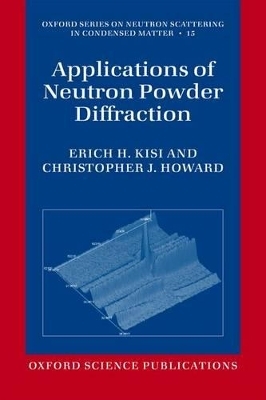
Applications of Neutron Powder Diffraction
Seiten
2012
Oxford University Press (Verlag)
978-0-19-965742-1 (ISBN)
Oxford University Press (Verlag)
978-0-19-965742-1 (ISBN)
- Titel ist leider vergriffen;
keine Neuauflage - Artikel merken
This is the first book covering the theory, practicalities, and the extensive applications of neutron powder diffraction in materials science, physics, chemistry, mineralogy, and engineering. The broad coverage should be accessible to graduate students and senior undergraduates in science and engineering, as well as lecturers and researchers.
This is the first book covering the theory, practicalities, and the extensive applications of neutron powder diffraction in materials science, physics, chemistry, mineralogy and engineering. Various highlight applications of neutron powder diffraction are outlined in the introduction, then the theory is developed and instrumentation described sufficient for a return to the applications. The book covers the use of neutron powder diffraction in the solution (hard) and refinement (more straightforward) of crystal and magnetic structures, applications of powder diffraction in quantitative phase analysis, extraction of microstructural information from powder diffraction patterns, and the applications of neutron diffraction in studies of elastic properties and for the measurement of residual stress. Additional theory to underpin these various applications is developed as required. Much of the material should be accessible to senior undergraduates in science and engineering, as well as to graduate students and more senior researchers with an interest in the technique.
This is the first book covering the theory, practicalities, and the extensive applications of neutron powder diffraction in materials science, physics, chemistry, mineralogy and engineering. Various highlight applications of neutron powder diffraction are outlined in the introduction, then the theory is developed and instrumentation described sufficient for a return to the applications. The book covers the use of neutron powder diffraction in the solution (hard) and refinement (more straightforward) of crystal and magnetic structures, applications of powder diffraction in quantitative phase analysis, extraction of microstructural information from powder diffraction patterns, and the applications of neutron diffraction in studies of elastic properties and for the measurement of residual stress. Additional theory to underpin these various applications is developed as required. Much of the material should be accessible to senior undergraduates in science and engineering, as well as to graduate students and more senior researchers with an interest in the technique.
Erich H. Kisi, School of Engineering, The University of Newcastle, Australia Christopher J. Howard, School of Engineering, The University of Newcastle, Australia
1. Introduction to neutron powder diffraction ; 2. Theory - the bare essentials ; 3. Basic instrumentation and experimental techniques ; 4. Elements of data analysis ; 5. Crystal structures ; 6. Ab initio structure solution ; 7. Magnetic structures ; 8. Quantitative phase analysis ; 9. Microstructural data from powder patterns ; 10. Diffuse scattering - thermal, short range order, gaseous, liquid and amorphous scattering ; 11. Stress and elastic constants ; 12. New Directions
| Erscheint lt. Verlag | 27.9.2012 |
|---|---|
| Reihe/Serie | Oxford Series on Neutron Scattering in Condensed Matter ; 15 |
| Zusatzinfo | 182 b/w line drawings, 8 b/w photographs, 9 colour images |
| Verlagsort | Oxford |
| Sprache | englisch |
| Maße | 172 x 233 mm |
| Gewicht | 746 g |
| Themenwelt | Naturwissenschaften ► Chemie |
| Naturwissenschaften ► Geowissenschaften ► Geologie | |
| Naturwissenschaften ► Geowissenschaften ► Geophysik | |
| Naturwissenschaften ► Geowissenschaften ► Mineralogie / Paläontologie | |
| Naturwissenschaften ► Physik / Astronomie | |
| Technik ► Maschinenbau | |
| ISBN-10 | 0-19-965742-4 / 0199657424 |
| ISBN-13 | 978-0-19-965742-1 / 9780199657421 |
| Zustand | Neuware |
| Haben Sie eine Frage zum Produkt? |
Mehr entdecken
aus dem Bereich
aus dem Bereich


